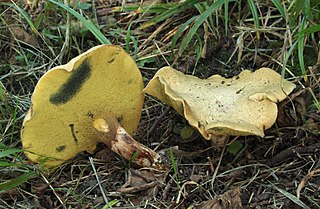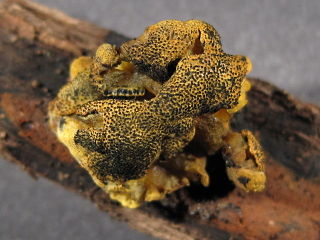Related Research Articles

Pier Andrea Saccardo was an Italian botanist and mycologist. He was also the author of a color classification system that he called Chromotaxia. He was elected to the Linnean Society in 1916 as a foreign member. His multi-volume Sylloge Fungorum was one of the first attempts to produce a comprehensive treatise on the fungi which made use of the spore-bearing structures for classification.

Gyrodon lividus, commonly known as the alder bolete, is a pored mushroom bearing close affinity to the genus Paxillus. Although found predominantly in Europe, where it grows in a mycorrhizal association with alder, it has also recorded from China, Japan and California. Fruit bodies are distinguished from other boletes by decurrent bright yellow pores that turn blue-grey on bruising. G. lividus mushrooms are edible.

Neottiella is a genus of fungi in the family Pyronemataceae. It was circumscribed by Italian mycologist Pier Andrea Saccardo in 1889.
Pirottaea is a genus of fungi in the family Dermateaceae. The genus contained 26 species in 2009. It went up to about 48 species later.

Cudoniella is a genus of fungi in the family Helotiaceae. The genus contains an estimated 30 species. Cudoniella was circumscribed by mycologist Pier Andrea Saccardo in 1889.

Gnomoniaceae is a family of fungi in the order Diaporthales. The family was circumscribed by German botanist Heinrich Georg Winter in 1886.
Gnomoniella is a genus of fungi in the family Gnomoniaceae. The genus contains 13 species. Gnomoniopsis is a genus of fungi in the family Gnomoniaceae including:
Cesatiella is a genus of fungi in the family Hyponectriaceae.

Thuemenella is a genus of fungi in the family Hypoxylaceae. The genus was circumscribed in 1898 by Albert Julius Otto Penzig and Pier Andrea Saccardo.

Favolus, or honeycomb fungus, is a genus of fungi in the family Polyporaceae. The fruit bodies of Favolus species are fleshy with radially arranged pores on the underside of the cap that are angular and deeply pitted, somewhat resembling a honeycomb.

Job Bicknell Ellis was a pioneering North American mycologist known for his study of ascomycetes, especially the grouping of fungi called the Pyrenomycetes. Born and raised in New York, he worked as a teacher and farmer before developing an interest in mycology. He collected specimens extensively, and together with his wife, prepared 200,000 sets of dried fungal samples that were sent out to subscribers in series between 1878 and 1894. Together with colleagues William A. Kellerman and Benjamin Matlack Everhart, he founded the Journal of Mycology in 1885, forerunner to the modern journal Mycologia. He described over 4000 species of fungi, and his collection of over 100,000 specimens is currently housed at the herbarium of the New York Botanical Gardens. Ellis had over 100 taxa of fungi named in his honor.
Benjamin Matlack Everhart was an American mycologist from West Chester, Pennsylvania.

Holwaya is a genus of fungi in the family Bulgariaceae. Holwaya is monotypic, containing the single species Holwaya mucida, which was originally named Bulgaria ophiobolus by Job Bicknell Ellis in 1883, and later transferred to the newly created Holwaya by Pier Andrea Saccardo in 1889. The genus name of Holwaya is in honour of Edward Willet Dorland Holway (1853-1923), who was an American botanist (Mycology) and Banker.

Clavulinopsis umbrinella, commonly known as the beige coral, is a coral mushroom in the family Clavariaceae. Fruit bodies are initially white before turning pale brown with darker brown tips. Originally described in 1860, it is known to occur in Europe and North America where it grows in grass. It is not a common species.
Pluteus aethalus is a species of agaric fungus in the family Pluteaceae. It is found in Cuba. The species was originally named Agaricus aethalus by Miles Joseph Berkeley & Moses Ashley Curtis in 1869, and later transferred to the genus Pluteus by Pier Andrea Saccardo in 1887. It is classified in Pluteus section Celluloderma, subsection Mixtini.

The ITT 465L Strategic Air Command Control System was a Cold War "Big L" network of computer and communication systems for command and control of Strategic Air Command "combat aircraft, refueling tankers, [and] ballistic missiles". International Telephone and Telegraph was the prime contractor for Project 465, and SACCS had "Cross Tell Links" between command posts at Offutt AFB, March AFB, & Barksdale AFB (SACCS also communicated with the Cheyenne Mountain Complex and Air Force command posts. The 465L System included IBM AN/FSQ-31 SAC Data Processing Systems, Remote and Simplex Remote Communication Systems, SAC Network Control Office, "4-wire, Schedule 4, Type 4B alternate voice-data operation", and one-way communication with "ICBM launch control centers" In addition to IBM for the "Super SAGE type computers", another of the 6 direct subcontractors was AT&T,

Mycena subcaerulea is a species of mushroom-forming fungus in the family Mycenaceae. It produces small, thin-fleshed fruitbodies with pale bluish-green caps upon slender stipes. The centers of the caps are darker in colour than the margins, and the cap cuticle can be peeled off. The fungus was first described in 1873 as Agaricus subcaeruleus by American mycologist Charles Horton Peck. His original collections, found growing on the trunks of decaying beech trees, were made in woods of the Adirondack Mountains in Upstate New York. Pier Andrea Saccardo transferred the species to the genus Mycena in 1887.

Geopyxis vulcanalis, commonly known as the vulcan pixie cup, is a species of cup fungus in the family Pyronemataceae. It was first described scientifically in 1878 by American mycologist Charles Horton Peck, from collections made in the Adirondack Mountains in Upstate New York. Pier Andrea Saccardo transferred it to the genus Geopyxis in 1889. Fruitbodies of G. vulcanalis are small and cup-like, with a light yellow hymenium. They become somewhat flattened in age. It grows on the ground in unburned conifer litter, often with mosses. Its spores are smooth and elliptical, measuring 14–21 by 8–11 µm.
Vizella is a genus of leaf-inhabiting fungi in the class Dothideomycetes, and the type genus of the family Vizellaceae. The genus was circumscribed by Pier Andrea Saccardo in 1883.
References
- ↑ Saccardo PA, Saccardo D (1906). "Supplementum universale. Pars VII. Discomycetae-Deuteromycatae" (in Latin). 18: 485.
{{cite journal}}: Cite journal requires|journal=(help) - ↑ "Monochaetia coryli (Rostr.) Sacc. & D. Sacc., Sylloge Fungorum 18: 485". MycoBank. International Mycological Association. Retrieved 2014-01-22.
- ↑ Rostrup FGE. (1895). "Mykologiske meddelelser. V. Spredle jaxttagelser fra 1893" (PDF). Botanisk Tidsskrift (in Swedish). 19: 201–18. Archived from the original (PDF) on 2014-02-02. Retrieved 2014-01-23.